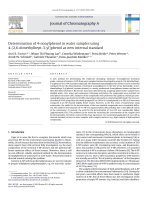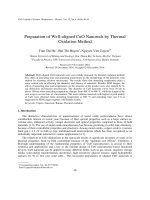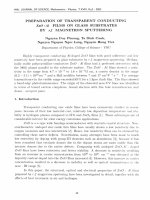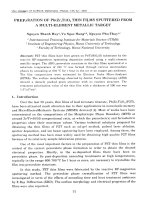DSpace at VNU: Preparation of platinum nanoparticles in liquids by laser ablation method
Bạn đang xem bản rút gọn của tài liệu. Xem và tải ngay bản đầy đủ của tài liệu tại đây (1.42 MB, 6 trang )
Home
Search
Collections
Journals
About
Contact us
My IOPscience
Preparation of platinum nanoparticles in liquids by laser ablation method
This content has been downloaded from IOPscience. Please scroll down to see the full text.
2014 Adv. Nat. Sci: Nanosci. Nanotechnol. 5 035011
( />View the table of contents for this issue, or go to the journal homepage for more
Download details:
IP Address: 198.91.36.79
This content was downloaded on 21/02/2015 at 08:47
Please note that terms and conditions apply.
|
Vietnam Academy of Science and Technology
Advances in Natural Sciences: Nanoscience and Nanotechnology
Adv. Nat. Sci.: Nanosci. Nanotechnol. 5 (2014) 035011 (5pp)
doi:10.1088/2043-6262/5/3/035011
Preparation of platinum nanoparticles in
liquids by laser ablation method
The Binh Nguyen, Thanh Dinh Nguyen, Quang Dong Nguyen and
Thi Trinh Nguyen
Department of Physics, University of Science, Vietnam National University in Hanoi (VNU HN), 334
Nguyen Trai Street, Hanoi, Vietnam
E-mail:
Received 10 April 2014
Accepted for publication 16 July 2014
Published 12 August 2014
Abstract
Platinum (Pt) nanoparticles were prepared in solutions of ethanol and TSC (trisodium citrate—
Na3C6H5O7.nH2O) in water by laser ablation method using Nd:YAG laser. The role of laser
fluence, laser wavelength and concentration of surfactant liquids in laser ablation process were
investigated. The morphology, size distribution and optical properties of the Pt nanoparticles
(NPs) were observed by transmission electron microscopy (TEM), UV-vis spectrometer and xray diffraction measurements. The average diameter of Pt NPs prepared in ethanol and TSC
solutions ranges around 7–9 nm and 10–12 nm, respectively. The results showed advantages of
the laser ablation method.
Keywords: nanoparticle, surfactant, laser ablation, plasmon resonance absorption
Classification numbers: 2.02, 4.02
1. Introduction
of nanoparticles by changing the nature of liquid carrier
medium [9].
We have previously reported our investigations on the
formation of silver and gold nanoparticles by laser ablation in
several liquids [10, 11]. In this paper, we report our investigations of Pt NPs preparation in clean and biologicallyfriendly liquids such as pure water, ethanol and TSC solution
in water by laser ablation.
Colloidal noble metal nanoparticles are of great interest
because of their size dependent optical properties, magnetic
properties and catalytic activities. Noble metal nanoparticles
in liquid environment have become a promising material for a
variety of applications such as nonlinear optical devices,
optical recording media, biosensing and bioimaging applications. Among noble metal nanoparticles, platinum and its
alloy nanoparticles have attracted much attention because
they are excellent catalysts for many purposes [1–5].
Many techniques have been developed to prepare metal
nanoparticles such as chemical reduction, electrochemical
reduction, radiolytic reduction, laser ablation.
Laser ablation in liquids is promising as a rapid, simple
and most versatile technique to prepare noble metal nanoparticles for analytical chemical and biological sensing
applications. Metal nanoparticles could be prepared by laser
ablation in clean liquids without contamination.
Surface contamination during laser ablation is greatly
reduced compared to the standard chemical synthesis involving reduction of metal salts because the particles are formed
directly from ablation of a pure target in a pure solvent [6–8].
In addition, laser ablation provides a technique to control size
2043-6262/14/035011+05$33.00
2. Experimental
Platinum nanoparticles were prepared by laser ablation of a
platinum plate (99.9% in purity) in 10 ml liquid. The liquid is
a solution of TSC or ethanol in water with different concentrations. A Nd:YAG laser (Quanta Ray Pro 230-USA) was
set in Q-switching mode to give laser pulses of 8 ns duration
with repetition rate of 10 Hz. The laser beam with different
wavelengths (1064 nm, 532 nm and 355 nm) was focused on
the Pt plate by a lens having the focal length of 150 mm. The
liquid vessel was placed on a horizontal platform, which
executed repetitive circular motions at a constant speed to
prevent agglomeration of particles. The solution became
colored under action of the laser beam. A small amount of the
colored solution was extracted for absorption measurement
1
© 2014 Vietnam Academy of Science & Technology
T B Nguyen et al
Adv. Nat. Sci.: Nanosci. Nanotechnol. 5 (2014) 035011
Figure 1. TEM images of Pt NPs prepared by laser ablation in TSC solutions of (a) 0.1 g L−1, (b) 0.5 g L−1 and (c) 1 g L−1.
and TEM observation. The absorption spectrum was measured by a Shimadzu UV-vis 2450 spectrometer. The TEM
micrograph was taken by a JEM 1010-JEOL. The size of
nanoparticles was determined by ImagieJ 1.37V software
from Wayne Rasband (National institutes of Health, USA).
The size distribution was obtained by measuring the diameter
of more than 500 particles and using Origin 7.5 software.
size distribution shows the mean diameters of Pt NPs prepared in TSC solutions of 0.1 g L−1, 0.5 g L−1 and 1 g L−1 are
7 nm, 8 nm and 9 nm, respectively.
The UV-vis absorption spectra of Pt nanoparticle colloids
prepared in TSC solutions are shown in figure 3. The characteristic plasmon resonance absorption peaks of Pt nanoparticle colloids prepared in 0.1 g L−1, 0.5 g L−1 and 1 g L−1
TSC solutions are 226 nm, 247 nm and 266 nm, respectively.
The results show that mean size of Pt NPs changes clearly
when TSC concentration increases from 0.1 g L−1 to 1 g L−1.
The x-ray diffraction (XRD) pattern of the Pt NPs show
in figure 4 three peaks at 2θ = 39.8°, 46.3° and 67.4° corresponding to the characteristic diffraction peaks of face centered cubic (fcc) lattice of Pt.
We repeated the laser ablation procedure with 532 nm
and 355 nm wavelength of Nd:YAG laser. Figure 5 shows
absorption spectra of colloidal Pt NPs prepared in 5 g L−1
TSC solution by 1064 nm, 532 nm and 355 nm wavelengths
with average laser power of 450 mW.
The results in figure 5 show that the absorption peak
corresponding to the wavelength of 1064 nm is highest,
meanwhile the one corresponding to the wavelength of
355 nm is lowest. That means the laser ablation efficiency is
lowest at the laser wavelength of 355 nm in this experimental
condition. The low laser ablation efficiency can be explained
by the absorption effect of Pt NP colloid on laser beam of
355 nm wavelength which is near the resonance plasmon
absorption peak of Pt NPs.
3. Results and discussion
3.1. Preparation of Pt nanoparticles in TSC solution
We chose TSC (trisodium citrate-Na3C6H5O7.nH2O,) solution in water because it is a non-toxic and biocompatible
solution. The TSC solution in distilled water was prepared
with different concentrations.
The morphology and size of metal nanoparticles depend
on many factors such as laser fluence, laser irradiation time,
laser wavelength and concentration of surfactant solution in
laser ablation process. We considered all these factors to get a
suitable laser ablation procedure. Using 1064 nm wavelength
of Nd:YAG laser with average power of 450 mW, irradiation
time of 15 min we prepared Pt NPs in TSC solution with
concentrations of 0.1 g L−1, 0.5 g L−1 and 1 g L−1.
The TEM images of colloidal Pt NPs were presented in
figure 1. The TEM images show that the Pt NPs are rather
spherical in shape. The data of size and size distribution of Pt
NPs were analyzed and are given in figure 2. Analysis from
2
T B Nguyen et al
Adv. Nat. Sci.: Nanosci. Nanotechnol. 5 (2014) 035011
−1
−1
Figure 2. The size distributions of Pt nanoparticle colloids prepared in TSC solutions of (a) 0.1 g L , (b) 0.5 g L
and (c) 1 g L−1.
Figure 4. XRD pattern of the Pt NPs prepared in TSC solution.
The results show that the diameter of Pt NPs ranges from
2 nm to 20 nm and the mean diameter of Pt NPs is 9 nm. The
XRD pattern showed the same peaks as Pt NPs prepared in
TSC solution (three peaks at 2θ = 39.8°, 46.3° and 67.4°).
The laser ablation of platinum was carried out by different laser powers with the same irradiation time of 15 min
and wavelength of 1064 nm. The UV-vis absorption spectra
of Pt NP colloids prepared by average laser powers of
400 mW, 500 mW and 600 mW are presented in figure 7.
As seen in figure 7 the position of absorption peak is
almost unchanged when the average laser power increases
Figure 3. The UV-vis absorption spectra of Pt nanoparticle colloids
prepared in TSC solutions of 0.1 g L−1(a), 0.5 g L−1 (b) and
1 g L−1 (c).
3.2. Preparation of Pt NPs in ethanol solution
By the same method we prepared Pt NPs in ethanol solution.
Figure 6 shows TEM image, size distribution and XRD
spectrum of the Pt NPs prepared in 40% ethanol solution in
water using 1064 nm wavelength with the average laser
power of 500 mW and laser irradiation time of 15 min.
3
T B Nguyen et al
Adv. Nat. Sci.: Nanosci. Nanotechnol. 5 (2014) 035011
Figure 7. The absorption spectra of Pt NP colloids produced by
Figure 5. The absorption spectra of colloidal Pt NPs prepared in
average laser powers of (a) 400 mW, (b) 500 mW and (c) 600 mW.
−1
5 g L TSC solution by wavelengths of (a) 1064 nm, (b) 532 nm
and (c) 355 nm.
The position of characteristic plasmon resonance
absorption peaks of colloidal Pt NPs is shifted from 260 nm to
272 nm when the ethanol concentration increases from 0 to
80%. According to Mie’s theory, that means the size of Pt
NPs increases when the ethanol concentration increases [12–14].
from 400 mW to 600 mW. The increase of laser power affects
unnoticeably the size of Pt nanoparticles prepared in ethanol
solution. Meanwhile, the laser ablation efficiency increases
when average laser powers increases from 400 mW to
500 mW and then remains unchanged when average laser
power increases from 500 mW to 600 mW.
Using average laser powers of 500 mW we considered
the laser ablation of Pt plate in pure water and ethanol solutions in water of different concentrations (20%, 40%, 60%,
80%). The UV-vis absorption spectra of the colloidal Pt NPs
are given in figure 8.
4. Conclusion
Pt NPs were prepared in TSC and ethanol solutions in water
by laser ablation method. The influence of laser fluence, laser
Figure 6. (a) TEM image, (b) size distribution and (c9 XRD spectrum of the Pt NPs prepared in 40% ethanol solution in water.
4
T B Nguyen et al
Adv. Nat. Sci.: Nanosci. Nanotechnol. 5 (2014) 035011
References
[1] Mafune F, Kohno J, Takeda Y and Kondow T 2003 J. Phys.
Chem. B 107 4218
[2] Wilcoxon J P, Martin J E, Parsapour F, Wiedenman B and
Kelley D F 1998 J. Chem. Phys. 108 9137
[3] Haruta M, Tsubota M, Kobayashi T, Kageyama H,
Genet M J and Delmon B 1993 J. Catal. 144 175
[4] Sakurai H and Haruta M 1995 Appl. Catal. A: General 127 93
[5] Nichols W T, Sasaki T and Koshizaki N 2006 J. Appl. Phys.
100 114912
[6] Sylvestre J P, Kabashin A V, Sacher E, Meunier M and
Lu-ong J H T 2004 J. Am. Chem. Soc. 126 7176
[7] Park D K, Lee S J, Lee J H, Choi M Y and Han S W 2010
Chem. Phys. Lett. 484 254
[8] Tilaki R M, Iraji zad A and Mahdavi S M 2007 Appl. Phys. A
88 415
[9] Tilaki R M, Iraji zad A and Mahdavi S M 2007 J. Nanopart.
Res. 9 853
[10] Nguyen T B et al 2011 Advances in Optics, Photonics,
Spectroscopy and Application (Hanoi: Publishing House for
Science and Technology) pp 155–60
[11] Nguyen T B et al 2011 VNU J. Sci. Math.-Phys. 27 51
[12] Cowley A and Woodward B 2011 Platinum Metals Rev. 55 98
[13] Athanassiou E K, Grass R N and Stark W J 2008
Nanotechnology 17 1668
[14] Mafune F, Kohno J and Takeda Y 2001 J. Phys. Chem. B
105 9050
Figure 8. The absorption spectra of Pt NPs in water (a) and in
different concentrations of ethanol solutions of 20% (b), 40% (c),
60% (d) and 80% (e).
wavelength and concentration of surfactant liquids on morphology, size distribution and optical properties of Pt NPs
were investigated to get a suitable laser ablation procedure.
The mean size of Pt NPs changed clearly when using different
concentrations of TSC and ethanol in water. This result
supports a size control method in preparation of Pt NPs by
laser ablation.
Acknowledgments
This research was supported by the Project QGTD. 13.03,
VNU Hanoi.
5









